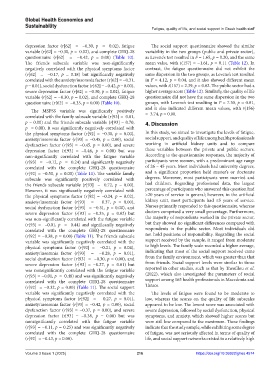Page 224 - GHES-3-1
P. 224
Global Health Economics and
Sustainability
Fatigue, quality of life, and social support in Greek health staff
depression factor (r[62] = −0.30, p = 0.02), fatigue The social support questionnaire showed the similar
variable (r[62] = −0.30, p = 0.02), and complete GHQ-28 variability in the two groups (public and private sector),
questionnaire (r[62] = −0.42, p = 0.00) (Table 10). as Levene’s test resulted in F = 1.65, p = 0.20, and the same
The friends subscale variable was non-significantly mean value, with t(157) = −1.61, p = 0.11 (Table 12). In
negatively correlated with the physical symptoms factor contrast, the fatigue questionnaire did not exhibit the
(r[62] = −0.17, p = 0.18) but significantly negatively same dispersion in the two groups, as Levene’s test resulted
correlated with the anxiety/insomnia factor (r[62] = −0.31, in F = 4.12, p = 0.04, and it also showed different mean
p = 0.01), social dysfunction factor (r[62] = −0.42, p = 0.00), values, with t(157) = 2.39, p = 0.02. The public sector had a
severe depression factor (r[62] = −0.30, p = 0.02), fatigue higher average score (Table 12). Similarly, the quality of life
variable (r[62] = −0.30, p = 0.02), and complete GHQ-28 questionnaire did not have the same dispersion in the two
questionnaire (r[62] = −0.35, p = 0.00) (Table 10). groups, with Levene’s test resulting in F = 7.30, p = 0.01,
and it also indicated different mean values, with t(156)
The MSPSS variable was significantly positively
correlated with the family subscale variable (r[93] = 0.81, = 3.74, p = 0.00.
p = 0.00) and the friends subscale variable (r[93] = 0.70, 4. Discussion
p = 0.00). It was significantly negatively correlated with
the physical symptoms factor (r[92] = −0.30, p = 0.00), In this study, we aimed to investigate the levels of fatigue,
anxiety/insomnia factor (r[93] = −0.45, p = 0.00), social social support, and quality of life among health professionals
dysfunction factor (r[93] = −0.45, p = 0.00), and severe working in artificial kidney units and to compare
depression factor (r[93] = −0.46, p = 0.00) but was these variables between the private and public sectors.
non-significantly correlated with the fatigue variable According to the questionnaire responses, the majority of
(r[93] = −0.12, p = 0.24) and significantly negatively participants were women, with a predominant age range
correlated with the complete GHQ-28 questionnaire of 26 – 45 years. Most individuals had university degrees,
(r[92] = −0.50, p = 0.00) (Table 11). The variable family and a significant proportion held master’s or doctorate
subscale was significantly positively correlated with degrees. Moreover, most participants were married and
the friends subscale variable (r[93] = 0.72, p = 0.00). had children. Regarding professional data, the largest
However, it was significantly negatively correlated with percentage of participants who answered this question had
the physical symptoms factor (r[92] = −0.24, p = 0.02), >20 years of service in general; however, in the artificial
anxiety/insomnia factor (r[93] = −0.37, p = 0.00), kidney unit, most participants had ≤5 years of service.
social dysfunction factor (r[93] = −0.31, p = 0.00), and Nurses primarily responded to this questionnaire, whereas
severe depression factor (r[93] = −0.35, p = 0.02) but doctors comprised a very small percentage. Furthermore,
was non-significantly correlated with the fatigue variable the majority of respondents worked in the private sector,
(r[93] = −0.01, p = 0.44) and significantly negatively but they showed no significant differences compared with
correlated with the complete GHQ-28 questionnaire respondents in the public sector. Most individuals did
(r[92] = −0.38, p = 0.00) (Table 11). The friends subscale not hold positions of responsibility. Regarding the social
variable was significantly negatively correlated with the support received by the sample, it ranged from moderate
physical symptoms factor (r[92] = −0.21, p = 0.04), to high levels. The family scale recorded a higher average,
anxiety/insomnia factor (r[93] = −0.28, p = 0.01), indicating that most of the social support received came
social dysfunction factor (r[93] = −0.30, p = 0.00), and from the family environment, which was greater than that
severe depression factor (r[93] = −0.27, p = 0.01) but from friends. Social support levels were similar to those
was nonsignificantly correlated with the fatigue variable reported in other studies, such as that by Theofilou et al.
(r[93] = −0.01, p = 0.48) and was significantly negatively (2022), which also investigated the parameters of social
correlated with the complete GHQ-28 questionnaire support among 165 health professionals in Macedonia and
(r[92] = −0.32, p = 0.00) (Table 11). The social support Thrace.
variable was significantly negatively correlated with the The levels of fatigue were found to be moderate to
physical symptoms factor (r[92] = −0.27, p = 0.01), low, whereas the scores on the quality of life subscales
anxiety/insomnia factor (r[93] = −0.42, p = 0.00), social appeared to be low. The lowest score was associated with
dysfunction factor (r[93] = −0.37, p = 0.00), and severe severe depression, followed by social dysfunction, physical
depression factor (r[93] = −0.38, p = 0.00) but was symptoms, and anxiety, which showed higher scores but
nonsignificantly correlated with the fatigue variable were still low compared to the maximum. These findings
(r[93] = −0.11, p = 0.25) and was significantly negatively indicate that the study sample, while exhibiting some degree
correlated with the complete GHQ-28 questionnaire of fatigue, was not seriously affected in terms of quality of
(r[92] = −0.43, p = 0.00). life, and social support networks existed to a relatively high
Volume 3 Issue 1 (2025) 216 https://doi.org/10.36922/ghes.4574

